Text
Like mosaic to my ears
Session 6: Visit to the Henry Moore Institute
Leeds marked the last trip of the academic year, with the most memorable visit being the first - the Henry Moore Institute.
While the archives gave off an almost musty, dated atmosphere - with the furniture being older than I am. The exhibit A State of Matter: Modern and Contemporary Glass Sculpture, lifted the building to new heights. The exploration into glass shifted the growing dust on the craft and how, with modern ideas, this medium can be used to produce ground-breaking contemporary art.
This exhibit is split into thirds; solid, gas and liquid.
Solid:
Within this section, a rather underwhelming, but sizable piece is ‘Any two-metre square sheet of glass to lean against any wall’ by Joseph Kosuth. The relationship between the artist and the artwork forms the conceptual ideas surrounding this outcome - while the art is merely a two-metre square sheet of glass, Kosuth brings into question the presumption of content and form.
This conceptual context is why I appreciate this piece, as it brings forth the notion of 'aesthetic choice' and what that means - the glass has no colour, no distinguishable marks present to provide a narrative. It is simply clean, sterilised.
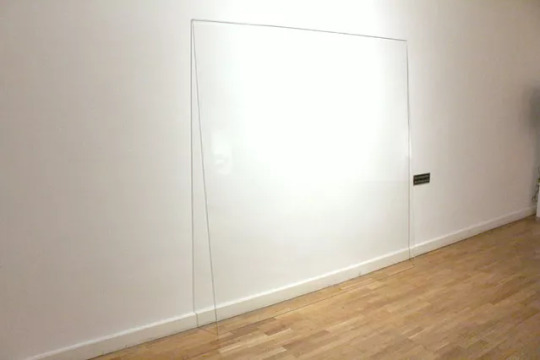
Which I thought was a nod to Covid-19 and why it was placed so closely to Luke Jerram’s Glass Microbiology series.
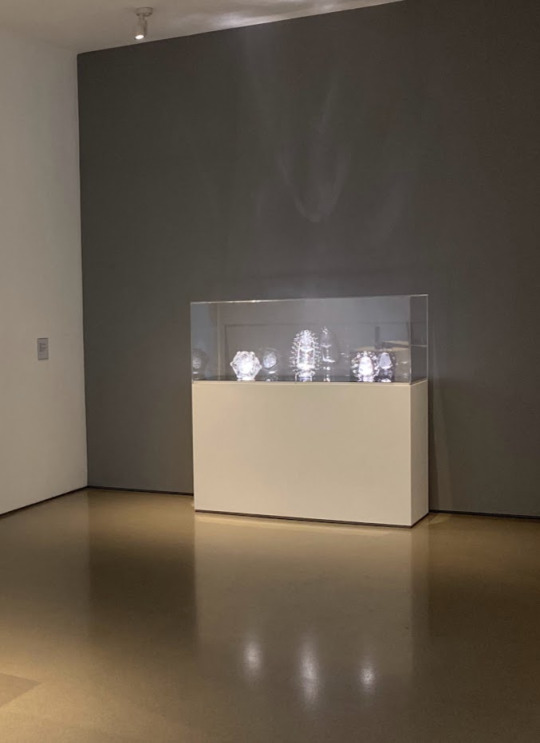
Gas:
When I first entered this section, I was slightly confused about the connection to gas. However, all of the pieces within this area had used the method of glassblowing.
Glassblowing is a technique in which the artist blows air into molten glass, simultaneously shaping and cooling it. This method has been around for centuries and is still considered a high skill technique, with artists taking years to master it.
A sculpture that caught my eye was ‘Mummy’s Little Soldier’ by Hew Locke.

The vibrant colours against the milky white background are what draws you in, it isn’t until you absorb the entire image does it become distorted. The piece twists the narratives of identity and race, using various influences to produce the artwork - the most apparent component is child soldiers, how fragile they are in comparison to the glass. Locke layered chains on the figure, which symbolise the amulets given to the children, promising them invulnerability.
Another connotation is Blackamoors, black figures that became popular within aristocratic homes as a decorative feature - solidifying Europe within the slave trade. Locke used the method of glassblowing as a nod to these figures whom he encountered in Venice - as the technique is most commonly found within the country, with it having historical roots.
By having these concepts shape his work, Locke allows the viewer to interact within the piece - it becomes more fluid. The fragility of the sculpture, combined with the disturbing subject matter makes the overall effect captivating.
Liquid:
The idea of glass as a liquid was captured by Glassporen (Glass Traces) a 12-minute film by Alexandra Engelfriet. The video showed the experiment of what would happen if the molten glass was poured on wet clay - by creating a film, Engelfriet followed the properties of a liquid.
Liquids have fixed volume but no fixed shape.
Liquids flow from higher to lower levels.
Liquids have their boiling points above room temperature, under normal conditions.
By producing an ever-changing medium, the artist allowed us to comprehend the journey the glass took. With the molten liquid initially flowing freely through the clay, going from high to low points - the camera follows this process. The glass had no shape, it merely gurgled away.
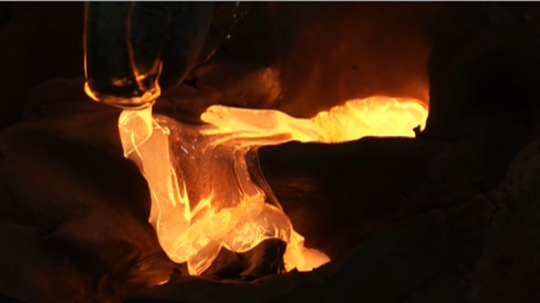
Then it began to cool and harden. Forming fragile bubbles, which cracked and shattered - leaving behind shards of glass. The change between liquid to solid wasn't beautiful but violent, contrasting with the other two sections. The explosions the glass experienced meant that the only living proof of the liquid glass was the film itself.
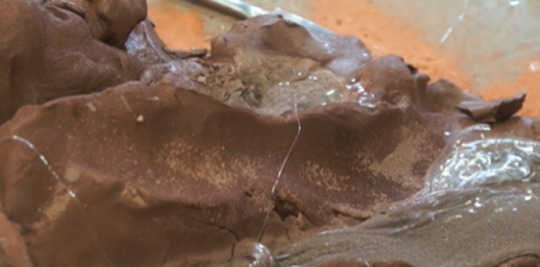
To watch the full film visit: https://www.alexandra-engelfriet.nl/film-II.php
This contemporary exhibit explored the different properties of a simple medium in such a unique way - it made us think through conceptual work from the likes of Joseph Kosuth. As well as through contextual art, that used a narrative to shape their subject and their medium like ‘Mummy’s Little Soldier’ by Hew Locke. As an individual that never looked at glass in a modern way, this show has provided a deeper insight into how artisans have pushed the boundary of something that is considered old and outdated.
0 notes
Text
Carved in tone.
REFLECTION:
When approaching how to write a blog, I decided I would google websites to see which ones are the best - however all of these cost money, so I just went with whatever was free. This is how I settled on Tumblr, the platform itself is fairly easy to navigate and I could pretty much start posting straight away - without having to design my page.
With my first post ‘Off to a flying art’, I wanted to set the tone for the blog as well as define what ‘Contemporary’ art could be. I decided to use a pun in the title in part because I thought it was funny, but mainly because I wanted to embody the informal side to the blog - especially as I would be writing more academically throughout the rest of semester two. I wanted the post to feel like more of a discussion, not a piece of writing that just talked at someone - to inform but leave some room for growth, that was my aim. I then followed the post with an illustration I created, Orange, to give an example of possible contemporary art - this would allow viewers to debate and question whether or not it is contemporary. Again, linking back to the idea of creating a discussion.
My ‘After all is said and tone’ post about how contemporary art communicated to an audience, within reference then to this idea of allowing others to make their interpretation - to build off their responses to previous inserts. I decided to use Saatchi as an example, due to his skill at manipulating the art market through communication - I believe it was a calculated move to use art that would provoke such a response, and ultimately increase the profit on the work when it sold. Overall this post was probably my least favourite to write, mainly because I still don’t 100% understand the concept of contemporary writing, even though I am most likely doing it now. Anyways…
When exploring HOME, in ‘A clay in the life', I found myself looking a bit further into contemporary art and organisations that exhibit it - how the gallery made the visit so refreshing and new to what I have experienced before. Especially with the Saloon hang used in the spaces, which is normally seen within older, traditional galleries like the Walker - it was interesting to see it used within this setting. And while I didn’t like how HOME communicated their art with the booklet, I did have an appreciation for how it made people interpret pieces without influence.
My favourite blog entry has to be the Guest Lecturer, Sufea Mohamad Noor, in ‘All that and pen some’ - I found her work to be intriguing. Sufea herself was easy-going and was such a pleasure to listen to. I was genuinely interested in her practice and the journey she took to get there - the narrative changed as Sufea herself developed. Overall, I think my idea of contemporary art shifted, as Sufea takes an active role with her work - it isn’t just practical art, but through; institutional critique, relational aesthetics and socially engaged practice that Sufea defines her practice.
I think my blog has kept the informal writing that I wanted to implement, although sometimes the entries are a bit long - I do think that they convey the ideas and concepts that I have learnt so far in semester two.
0 notes
Photo

Portaloo: Smells like Roses
Here is another example of contemporary art. I made this piece purely for the aesthetics - I saw an image of someone running down the street literally wearing a portaloo and just found it funny. So I drew it.
Enjoy.
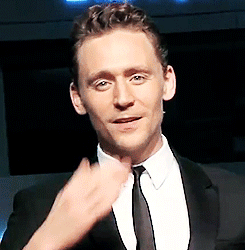
1 note
·
View note
Text
All that and pen some.
Session 5: Guest Lecture - Sufea Mohamad Noor

Well, aren't we all!
Today's guest lecture was probably one of my favourites - from Sufea’s inspirations to influence, I finally felt I could connect to the person in front of me.
We started the lecture with the classic introduction of what Sufea does and her role within the artistic community as the Development Assistant Officer for Tate Liverpool. However, it was her inspiration that made me sit straight in my seat. The early-on feminist role within Sufeas creative practice, following the works of Sutapa Biswas a British Indian conceptual artist was particularly interesting to me - Biswas performance piece Kali being Sufea’s main example. It was a direct challenge towards the colonial legacy present within the University of Leeds, in which Biswas was a student - it was described as a cleansing act with the notable feminist and art historian Griselda Pollock being a part of the work.
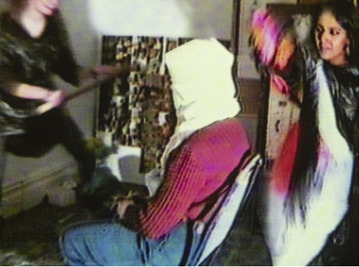
I was fascinated by this contemporary piece of work, the initiative to push forward despite the backlash of a constitution with more resources and the ability to stunt Biswas as an artist. Therefore I understood from the beginning that Sufea’s stance and drive towards her practice was in earnest, not theoretical but substantial.
Sofea explained what she does and how it links into the Art History Canon (or AHC for short). For those who may not be aware, the AHC typically describes an ideal standard in which things are measured against - and for AHC this is mainly; old, white, men (Mask. K, 2019) who, as you can imagine, can be particularly biased when it comes to picking what ‘good’ art is. Therefore, within Sufea creative practice, she takes on the role of challenging this canon, much like Biswas in the 80s.
Contrary to stereotypic belief, Sufea art isn’t always based on producing physical pieces - with her actions speaking just or even louder than art.
Sufea broke down her course of action into three separate elements; Institutional Critique, Relational Aesthetics and Socially Engaged Practice. Her methods to implement these segments through; Postcolonial Discourse, Anthropophagia and Arte Povera.
What does this mean?
It means that Sufea is looking at a bigger picture of relevant, purposeful change within Institutions like Tate, Universities, Galleries etc. She interweaves her objectives with art - embodying what it means to be a social artist. Through looking at Postcolonial Discourse, Sufea has developed her work with the concept of ‘Stop Asian Hate’ - bringing together a group of Asian creatives to produce five posters with Metal.
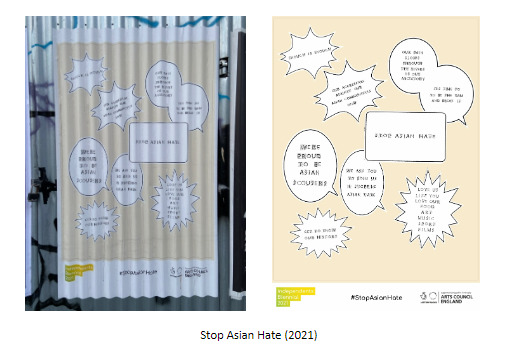
While initially viewing this piece, you may think it is a somewhat simple design - that does not have much of an impact. I know I did. However, the context behind the process of Sufea making the words was what struck me as significant. She used the names from the Chinese Merchant Seamen memorial to create the alphabet for the writing in each of the word bubbles. It's the act of repurposing these names to guarantee their legacy, consolidating their importance during a time where racism against the East-Asian community was (and is) rife. - with some of the posters being defaced or torn down.
Sufea's use of Anthropophagia, a concept born in the 60s meaning cannibalism, is crucial when exploring her engagement with independent artists. This reflects in her actions with taking ideas or materials from larger institutions (with their consent!) and sharing them with new, upcoming artists. For example, arranging private viewings for artists, with the intent of securing a patron or even providing information into how to get funding for projects. There is an element of reciprocity, by repurposing materials that may be useless to one person but invaluable to another.
Another active role that Sufea has assumed that should be counted as a part of her practice is her development of Arte Povera and the creation of Liverpool ESEA Creatives Network - and the support she supplies, with organised coffee mornings at the Tate. I feel as though by looking at Sufea's work and everything she has done, this is the core of her art. From the beginning of the lecture looking at Biswas, I could tell that the work she makes would translate into some more than just ‘art’.
Sufea combines all these elements within her practice, and that is what makes her work so interesting - a significant example of this is ‘The Resilience Garden’ project in 2018, though a little behind the ESEA creative network, Sufea embodied the idea of bringing people together no matter their ‘social status’ into an environment that was meant to show the beauty of nature.

Artists of all degrees were rubbing shoulders and sharing ideas, as well as with the local community. And by using the plants and herbs in the garden, Sufea was reusing and repurposing them - showing her interest in Anthropophagia.
As an artist, Sufea's work and ideology spoke to me, as a creative myself, I am always looking at how to do something through my art - despite having a small platform. And the idea that we explored at the end of the session with the question:
Think about the art history movements that inspire you and the values you want to practice
I chose Dada Zurich, a movement I have mentioned before, because of its concept of creation - I like the fact it contradicts itself, it means that topics can be explored without boundaries. I felt as though it was an example of how émigré artists can come together and just make art. And for me, sometimes that's what I do. I just do art for the sake of it. And while Dada is shrouded in the cloud of politics and war, I do think sometimes it was an outlet for people who wanted to just do something.
Bibliography:
MAST, K., 2019. The Art History Canon and the Art History Survey Course: Subverting the Western Narrative. The Journal of Social Theory in Art Education (Online), 39, pp. 40-51.
1 note
·
View note
Text
A clay in the life.
Session 4: Manchester - HOME
Welcome HOME.
When visiting Manchester and its many galleries, HOME stood out - not only for the name.
The Manchester Open exhibit that was showcased on the ground floor held such a diverse collection of work, from painting to installations. HOME also allowed visitors to vote for their favourite pieces, this would then go towards the People’s Choice Award - hopefully, one of my top three wins!
The space itself was curated so you would go around clockwise, each of the pieces was labelled with a number that would correspond to a booklet that gave you the artist's name, piece title and price (if applicable). I found this method of communication slightly fiddly, only because you constantly had to flip through pages. Going back to the last session, the overall effect of this particular anonymous way of writing, made me not appreciate the artwork as much. Due to the lack of context, there was no stepping stone to allow me to get into the mind of the artist, and fully comprehend what they were thinking. Which is an essential part when viewing contemporary art.
So why did they do it?
When considering why HOME set out 400+ artwork in such a way, I decided to look into the gallery. Their ethos behind this exhibit was that “art is for everyone, and the Manchester Open is a biennial celebration of creativity across Greater Manchester.” (HOME, 2022). The anonymity was to level the playing field, it meant that all of the art was taken seriously - no matter if it was done by a child or a complete amateur. It was ambiguous, and rightly so. As Marcel Duchamp once illustrated, it's artists that define the work they make, and it's their artistic intent that makes it art.(Judovitz.D and Duchamp.M, 2010).
Looking closer at the collection, I based my top three favourite pieces on my response - how it made me feel and what it made me think. I didn’t look into the artist or the context behind their work. I decided to follow the silent instructions given to me by the gallery.
In Third Place: 29 - Marian Jazmik with ‘Cacti’
My initial reaction to this mini sculpture was that the artist was exploring Covid-19 and the different variants present - this is due to HOME exhibiting multiple pieces by the artist. I also thought that they were adorable!
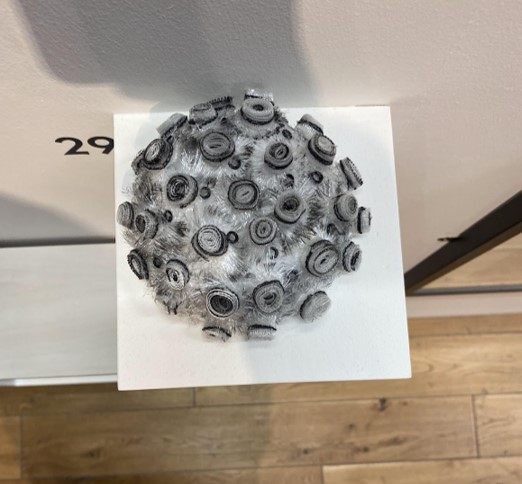
What first drew me to this piece was the detail, the use of textile creating the circular shapes that stuck out all over the dome. I almost immediately wanted to touch it, see how the different mediums affected the feeling of the cacti - was it spikey? Sharp? Rough? The use of plastic, especially the smaller, thin strips, reflected off the lights - adding to the different textures present, it highlighted the various materials, separating them. It was like the artist aimed this sculpture at your senses of touch and sight - the Cacti interacted with you, as well as the environment.
The initial connotations I made to Covid-19 is what made me put Cacti on my list. I thought that despite the artist naming it Cacti with its connection with the succulent, the ability to convey a completely different narrative showed its versatility. Therefore it stood out from the rest of the collection, which is the foremost reason for my vote.
In Second Place: 185 - Lilina Butler with ‘Cake and Frog’
This second-place vote was completely based on my own preferred aesthetic - as someone who loves cartoon, simplistic style art, ‘Cake and Frog’ was a bit of me!
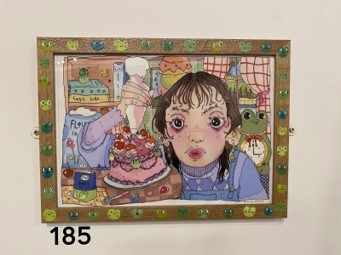
The overall impact of this work for its size was substantial, I was immediately drawn to the piece - the subject herself was so prominent, looking directly at you. It was clear that the artist had considered the composition, with how much content there is in such a small painting. The colour palette worked well for me, it wasn’t too bright or dark, but balanced. I felt as though this piece was taken straight from a cover of a manga, I just really enjoyed the work.
My choice based on aesthetics isn’t something I feel was substandard - but goes to show how most people do tend to gravitate towards something that is appealing to them. I would have loved to have this painting up in my room - I feel as though it would brighten up the place. The decoration on the frame, brought the imagery out of the flat canvas, with the different emotions shown by the frogs. It also brought the art together by consolidating the colours used.
First Place: 30 - Lee Hardman with ‘Making Faces I’
This painting held my attention. It was like the face was behind a piece of glass, blurred yet clear - it’s almost like a cloudy memory. Like when you’re trying to think of someone, but the face never truly appears.

Haunting is how I would describe ‘Making Faces I’, Hardman's ability to make some look whole but transparent at the same time is really impressive to me. And something that I don’t think I could do within my creative practice. It gave off a vulnerability to the subject, the hands didn’t look like their own - it was as though someone was telling or even forcing them to smile. My response to this work was to feel sympathy for the frail person in front of me, their eyes looked so sad, almost depressed.
The projection of such emotion is why I decided on this piece to be my first pick, it stayed with me as I went around the exhibit. I revisited it multiple times because I found it so interesting to view.
Visiting HOME to view this exhibit is something I would recommend, it was refreshing to see such different and distinctive art - instead of stuffy paintings or plain sculptures. The Manchester Open allowed me to explore not only different artists but also how galleries curate shows to best showcase work. Even though I found the booklet a bit annoying to use, I did think that letting the art speak for itself made me come up with interpretation - which then led me to appreciate this style of contemporary writing and curating.
Bibliography:
HOME (2022) Manchester Open Exhibition 2022 Available at: https://homemcr.org/exhibition/manchester-open-exhibition-2022/ (Accessed 10/02/2022)
Judovitz, D. & Duchamp, M. (2010) Drawing on art : Duchamp and company. Minneapolis: University of Minnesota Press.
1 note
·
View note
Text
After all is said and tone,
Session 3: Communicating Contemporary Art
How is contemporary art communicated to an audience?
When trying to convey a contemporary piece of work to an audience the meaning isn’t ‘fixed’ - unlike historical art which tends to follow a particular story or fable. Therefore it is down to the interpretation of the organisation, curator or artist themselves to put forward an explanation of a piece that makes the viewer have an emotional connection. While it is not imperative for an individual to like the work, there is a need for them to stop and absorb, as most people within the 21st century are used to only giving a few seconds of their attention.
Consequently, the essence of a ‘good’ art writing piece lies in the ability to make art more valuable to the reader, especially when it comes to writing about contemporary art. The two main methods of writing are; Explanation and Evaluation.
Explanatory writing provides a contextual and descriptive piece that include elements of fact, opinion and statements - it should be verifiable information, however, it will not be objective, there is always a motive behind them. Different mediums that include explanatory writing are press releases, wall captions, news articles or even auction catalogues. All of these forms are made with a purpose, whether that is to sell or to promote. Therefore one of the most important things to consider when looking at these examples is the question of ‘why?’. As it is this context that will ultimately provide the true insight behind the piece of art.
Whereas evaluation writing is used for judging or interpreting artwork, they follow a singular argument - commonly followed by questions and arguments that challenge something, this may be their opening statement or the piece itself. Overall evaluation pieces are found in academic texts, op-ed journalism or exhibits and book reviews.
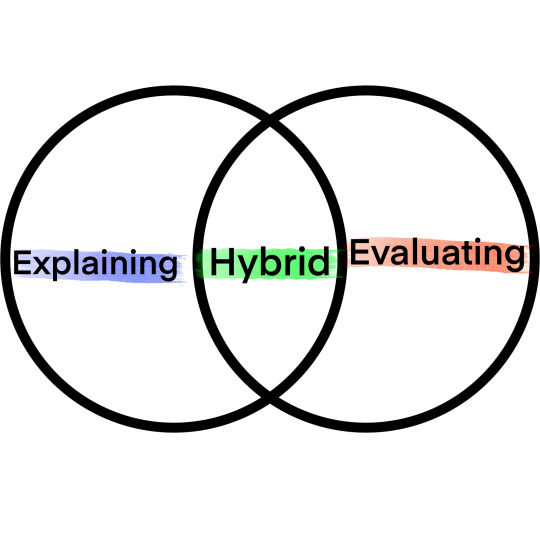
Many contemporary writing pieces will be ‘hybrids’, as not only do they need to communicate the facts but also the opinions and interpretations of the writer, to provide a complete outcome that will give the audience the stepping stone needed to form their response (Williams. G, 2017).
Why is this important to consider?
The conditions in which contemporary art is written or reported can set the tone for the art itself. There is a clear need for explanation and evaluation within contemporary art as sometimes there is no apparent context - as when the art is made it can be a direct reflection of that moment, or the artist's response to a moment (Smith.T, 2019). In truth the written explanation and evaluation is almost just as important as the piece itself because it is the bridge between the work and the audience - therefore it's just as significant to consider the writing style as it would the backdrop for an installation or painting.
Moreover, the impact isn’t just limited to curatorial practice but extends to the selling of art, with collectors such as Charles Saatchi using the media to their advantage to boost sales. A clear example of this would be the outrage from Mayor Rudy Giuliani about the Brooklyn Museum of Art exhibit, caused by Chris Ofili, ‘The Holy Virgin Mary’, a painting from Saatchi's private collection - that went on to create a spectacle. This led to numerous articles and widespread news about the piece and the artist, which ultimately allowed Saatchi to sell the painting for around £2.5 million (Reyburn.S, 2015).
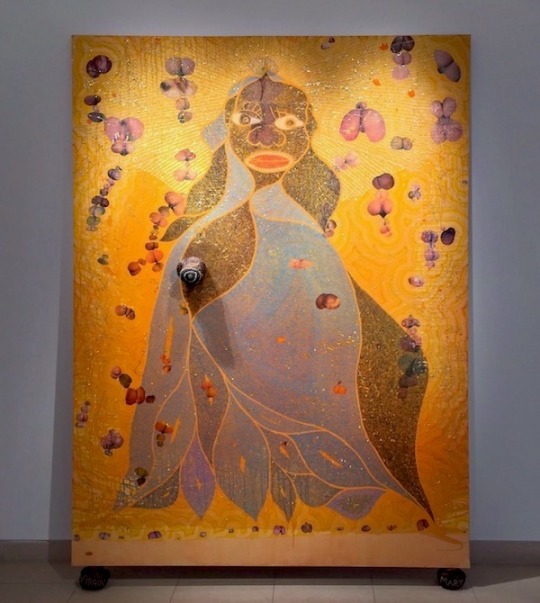
Chris Ofili: The Holy Virgin Mary
(P C Robinson Artlyst 2015)
This inflation is a primary example of the capability of contemporary art writing, due to the different discourses present within the painting itself, like post-colonialism, combined with the backlash it received - meant that Saatchi was essentially able to manipulate the market to facilitate that piece of work to make the most profit.
Do I blame him? No, I can’t say I do.
Hence why the communication of contemporary art has never been so critical within the 21st century, as its reach extends past the traditions of historical art. Furthermore, it presents the precedent that everything is not only up for debate but can now be challenged against the conservative white cannon that has decided what art should and can be. Giving way to postmodernist readings like feminism, LGBTQ+ etc. that can now be included and respected within contemporary writing.
To circle back then to the original question - How is contemporary art communicated to an audience?
Contemporary art is communicated through various methods, with various motives behind them all - whether that's to inform, judge, debate or describe. The one common thread is that there must be credibility behind the information, something writers must demonstrate to be seen as reliable. As no one is going to believe that Mayor Rudy Giuliani wanted to shut down the Brooklyn Museum of Art ‘Sensation’ exhibit in 1999 if it came from a notorious fibster journalist, who was just after a quick story - Saatchi wouldn’t have made a dime either.
Bibliography: Author surname, initial. (Year) Book title. City: Publisher.
Williams.G. (2017) HOW TO WRITE ABOUT CONTEMPORARY ART.: Thames&Hudson.
Smith, T. (2019) Art to come : histories of contemporary art. Durham: Duke University Press.
REYBURN. S (2015) Chris Ofili’s ‘The Holy Virgin Mary’ to Be Sold. New York: New York Times Company.
0 notes
Text
Kick-art your Day.
Session 2: Studio Tour - The Royal Standard
The early session start had me flying out of bed at 11:50, ordering an Uber and running down 4 flights of stairs for the 12 o’clock tour at The Royal Standard.
But let me just say, it was worth it!
When we first arrived at The Royal Standard we were greeted by an open space café and the clamour of artists working - creating the sense of an intimate and close-knit community within the studio. Elizabeth, one of the artist leads, greeted us with her dog Lilly (big bonus) in the dedicated gallery space. She went on to describe The Royal Standard as an artist-led studio designed by artists, for artists - with its ethos being centred on providing affordable and quality spaces for new or upcoming creatives.
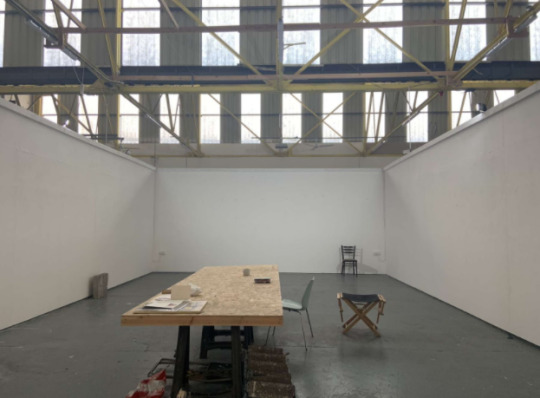
(Gallery Space) - Open, with plain white backgrounds ready for work. Primary Gallery Space for The Royal Standard
We then went into the communal area which was the centre for the private and shared studios - when inquiring about the pricing of the spaces, Elizabeth explained that the starting rate was £70 per month for a shared space.

(Communal Area) - Leads of to the private studio spaces, the white doors.
The overall feel of this area was interesting as it was a clash between the informal setting of the seating area, with surfaces littered with different types of mediums or books, to the private studios which seemed almost shut off. A perfect space for artists looking to focus and reflect on their work. A concept that may have come from the merging of the Bottega (workplace) and Studiolo (contemplation space) - these terms originated from ateliers in the Renaissance period and the idea of selling your art within international markets. Therefore to have the practical and entertaining spaces separate was ideal, however, this changed with the idea of art and it became a joint practice. Therefore it makes perfect sense for this area to provide a setting in which artists can showcase and relax, with their private studios just an arms reach away - allowing for the crossover of practical work and engagement of the viewer.

(Alleyway leading to The Royal Standard) - Very industrial space, despite it being a large building it was tucked away.
The location of The Royal Standard also highlighted the importance of providing a personable experience, as while it is a very large building, it was difficult to find within the Baltic Market - meaning it's imperative for its survival that the studio is so enticing. However, this isolation from public transport and other commodities, showcases how studio spaces arise within areas that are almost redundant. This is because they are cheap, with buildings that have been abandoned like factories which are easy to renovate. It's the economic pressure felt by the artistic community that means places with low rent and an unappealing nature is essential - which then, of course, is turned into a place of culture which ultimately means a rent increase…
BUT! Luckily for us, the Liverpool council has taken measures to ensure the consecration of such spaces, protecting the art spaces and their creatives from eviction.
The Royal Standard definitely set the grade in which other spaces should be held - the creators of this organisation has positioned themselves on the side of artists, allowing an opportunity to a wider range of creatives. They changed my idea of how a studio is meant to look - mainly overcrowded, dusty and just a bit naff. It clearly shows the development made within contemporary art, how the needs changed as well as the spaces themselves. This results in studios being used not only for testing out ideas but to have a space that can be used for networking - with artists needing the extra income made from these events, in order to pay for their space. In contrast to Historical artists, who had patrons to pay for and set up their creative studios, contemporary artists use temporary curating areas to produce work - with very few artists today owning their own workplace.
The visit made me realise the importance of collaborative spaces like The Royal Standard, as not only do they provide artists with affordable space in which to work, but they have created opportunities for other sectors in the art world, with their volunteering scheme. Elizabeth, our artist lead, described the process to be a 2-year process, at the end of which a new team is picked out - providing the organisation with fresh ideas, as well as keeping the turnover of participants high.
Overall I have to say I really enjoyed the visit to The Royal Standard, and would definitely recommend it to anyone - if not for the art, then for the coffee and Lilly the dog.
0 notes
Photo

An example of Contemporary Art: Orange
I created this outcome through the use of Procreate - I feel as though this shows the elements of contemporary art as it brings into question parts of our society like drugs, sex and alcohol. I wanted to explore the imagery related and create something that illustrates my own response. Despite its decorative appearance, the main point of the artwork is my thoughts behind each element, with its relevance only apparent to me. The concept is what brings it value.
0 notes
Text
Off to a flying art.
Session 1: So, What is Contemporary Art?
The origins of Contemporary Art have always been contested. This is due to its basic constitution of being “innovatory or avant-garde” - therefore wasn’t all art contemporary at one point?
A question stemmed from the idea that with each new technique, method and movement a contemporary piece was at its roots - because of its advanced nature. Therefore it can be argued that contemporary art started when the production of art did.
However, to avoid being problematic, the general time span of Contemporary Art is from around the 1920s, following the birth of movements such as Cubism, Dada etc. The exact moment could be connected with Marcel Duchamp in 1919, with his ready-mades - while others look to individuals such as Lawrence Alloway, who coined the term Pop Art, as the beginning of Contemporary Art in the 1950s.
Overall it can be agreed that its beginning occurred during the 20th century - however, this leads to the next issue of how long until art becomes historical?
During our discussion within my History of Art and Museums module, it became clear that the opinion of what defined art as contemporary or historical came down more to the subject matter rather than the style of work. In essence, a historical piece created in the 19th century or before tended to depict figures despite the inclusion of other features of a movement - for example, the Symbolists movement during the latter half of the 1800s in France, held imagery that could be considered as contemporary because of their unusual nature, however, they were still figurative. This meant that there was still an expectation within the works and a convention due to the time period, while with Contemporary Art anything goes.
Therefore when exploring the topic of ‘What is Contemporary Art’ we concluded that the pieces’ focus is more conceptual rather than aesthetic, with the subject matter being fluid and the media being varied - with outcomes being performed rather than physically produced.
I personally look to Contemporary Art as something that creates divisions with the art world, but instead of separating individuals, they create new paths for people to follow. It sets new lines and boundaries for artists to bend or break - whether they should do it or not. That is the freedom that comes with Contemporary Art.
An avenue that then came from Contemporary Art is Conceptual Art - a practice that involves the concept of the context is greater than the finished product. Resulting in outcomes that couldn’t be sold, which in itself opened up the question of Art within Capitalism and its effects. Overall its impact on the commercial side of art was limited as in order for artists to keep their studio spaces and practice running, they needed the revenue from their art - which is why conceptual art is now one of the best sellers.
In conclusion, Contemporary Art can be seen as something old and something new - as no matter how one person defines it, there is always an alternative interpretation. Nevertheless, I strongly believe that Contemporary Art sets the framework for other movements within our art history - as without innovative artists there wouldn’t have been any development.
1 note
·
View note